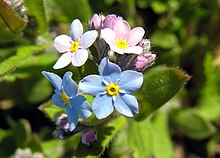Myosotis
This article may require cleanup to meet Wikipedia's quality standards. The specific problem is: grammar, order of information. (November 2016) (Learn how and when to remove this template message) |
Myosotis | |
|---|---|
 | |
Myosotis arvensis | |
Scientific classification | |
| Kingdom: | Plantae |
Clade: | Angiosperms |
Clade: | Eudicots |
Clade: | Asterids |
| Order: | Boraginales |
| Family: | Boraginaceae |
| Subfamily: | Boraginoideae |
| Genus: | Myosotis L. |
Type species | |
Myosotis scorpioides L. [1] | |
Myosotis (/ˌmaɪ.əˈsoʊtɪs/;[2] from the Greek: μυοσωτίς "mouse's ear", which the foliage is thought to resemble) is a genus of flowering plants in the family Boraginaceae. In the northern hemisphere they are colloquially denominated forget-me-nots[3] or Scorpion grasses. The colloquial name "Forget-me-not" was calqued from the German Vergissmeinnicht and first used in English in AD 1398 through King Henry IV of England.[4] Similar names and variations are found in many languages. Myosotis alpestris is the state flower of Alaska[5] and Dalsland, Sweden. Plants of the genus are commonly confused with Chatham Islands Forget-me-nots which belong to the related genus Myosotidium.
Contents
1 Distribution
2 Morphology
3 Ecology
4 References
5 External links
Distribution
More than 500 species names have been recorded, but only 74 species are presently accepted. The remainder are either synonyms of presently accepted or proposed names.[6]
The genus is largely restricted to western Eurasia with circa 60 confirmed species and New Zealand with circa 40 confirmed species. A paucity of species occur elsewhere including in North America, South America, and Papua New Guinea.[3] Despite this, Myosotis species are now common throughout temperate latitudes because of the introduction of cultivars and alien species. Many are popular in horticulture. They prefer moist habitats. In locales where they are not native, they frequently escape to wetlands and riverbanks. Only those native to the Northern hemisphere are colloquially denominated "Forget-me-nots".
Genetic analysis indicates that the genus originated in the Northern Hemisphere and that the species native to Australia, New Zealand and South America are all derived from a single dispersal to the Southern Hemisphere.[3] One or two European species, especially Myosotis sylvatica (wood forget-me-not) were introduced into most of the temperate regions of Europe, Asia, and the Americas.
Morphology
Myosotis species have 5-merous actinomorphic flowers with 5 sepals and petals. Flowers are typically 1 cm in diameter or less; flatly faced; colored blue, pink, white, or yellow with yellow centers; and borne on scorpioid cymes. They typically flower in Spring or soon after the melting of snow in alpine ecosystems. They are annual or perennial. The foliage is alternate. Their roots are generally diffuse.

Myosotis sylvatica
The seeds are contained in small, tulip-shaped pods along the stem to the flower. The pods attach to clothing when brushed against and eventually fall off, leaving the small seed within the pod to germinate elsewhere. Seeds can be collected by placing a sheet of paper under stems and shaking the seed pods onto the paper.
Myosotis scorpioides is also colloquially denominated scorpion grass because of the spiraling curvature of its inflorescence.
Ecology
Myosotis are food for the larvae of some Lepidoptera species including the setaceous Hebrew character. Many of the species in New Zealand are threatened.[7]
Presently 74 species are accepted in The Plant List:[6] of which 40 are endemic to New Zealand.[8] The full list of species includes:
Myosotis abyssinica Boiss. & Reut.
Myosotis afropalustris C.H. Wright
Myosotis albiflora Banks & Sol. ex Hook. f.
Myosotis alpestris F.W.Schmidt (alpine forget-me-not)
Myosotis alpina Lapeyr- Myosotis ambigens (Bég.) Grau
- Myosotis antarctica Hook. f.
Myosotis arvensis (L.) Hill (field forget-me-not)
Myosotis asiatica (Vestergr. ex Hultén) Schischk. & Serg. (Asiatic forget-me-not)
Myosotis azorica H.C. Watson (Azores forget-me-not)
Myosotis balbisiana Jord.
Myosotis baltica Sam. ex Lindm.
Myosotis bothriospermoides Kitag
Myosotis cadmea Kitag
Myosotis caespitosa Schultz (tufted forget-me-not)
Myosotis chaffeyorum Lehnebach
Myosotis decumbens Host
Myosotis discolor Pers (changing forget-me-not)
Myosotis densiflora C. Koch
Myosotis incrassata Guss.
Myosotis krylovii Serg.
Myosotis lamottiana (Braun-Blanq. ex Chass.) Grau
Myosotis latifolia Poir. (broadleaf forget-me-not)
Myosotis laxa Lehm. (tufted forget-me-not or bay forget-me-not)
Myosotis lithospermifolia Hornem.
Myosotis monroi (Monro's forget me not)
Myosotis macrosperma (Largeseed forget me not)
Myosotis mooreana Lehnebach
Myosotis nemorosa Besser
Myosotis petiolata var. pansa (L.B.Moore) Meudt, Prebble, R.J.Stanley & Thorsen subsp. pansa (Waitakere forget-me-not)
Myosotis ramosissima Rochel (early forget-me-not)
Myosotis rivularis (Vestergr.) A.P. Khokhr
Myosotis sachalinensis Popov
Myosotis scorpioides L. (true forget-me-not)
Myosotis secunda (creeping forget-me-not)
Myosotis sicula Guss. (Jersey forget-me-not)
Myosotis sparsiflora J.C.Mikan ex Pohl
Myosotis speluncicola Schott ex Boiss
Myosotis stenophylla Knaf
Myosotis stricta Link ex Roem. & Schult
Myosotis strigulosa Rchb.
Myosotis sylvatica Ehrh. ex Hoffm (wood forget-me-not)
Myosotis verna Nutt. (spring forget-me-not)
References
^ Carlos Lehnebach (2012). "Lectotypification of three species of forget-me-nots (Myosotis: Boraginaceae) from Australasia". Tuhinga. 23: 17–28..mw-parser-output cite.citationfont-style:inherit.mw-parser-output qquotes:"""""""'""'".mw-parser-output code.cs1-codecolor:inherit;background:inherit;border:inherit;padding:inherit.mw-parser-output .cs1-lock-free abackground:url("//upload.wikimedia.org/wikipedia/commons/thumb/6/65/Lock-green.svg/9px-Lock-green.svg.png")no-repeat;background-position:right .1em center.mw-parser-output .cs1-lock-limited a,.mw-parser-output .cs1-lock-registration abackground:url("//upload.wikimedia.org/wikipedia/commons/thumb/d/d6/Lock-gray-alt-2.svg/9px-Lock-gray-alt-2.svg.png")no-repeat;background-position:right .1em center.mw-parser-output .cs1-lock-subscription abackground:url("//upload.wikimedia.org/wikipedia/commons/thumb/a/aa/Lock-red-alt-2.svg/9px-Lock-red-alt-2.svg.png")no-repeat;background-position:right .1em center.mw-parser-output .cs1-subscription,.mw-parser-output .cs1-registrationcolor:#555.mw-parser-output .cs1-subscription span,.mw-parser-output .cs1-registration spanborder-bottom:1px dotted;cursor:help.mw-parser-output .cs1-hidden-errordisplay:none;font-size:100%.mw-parser-output .cs1-visible-errorfont-size:100%.mw-parser-output .cs1-subscription,.mw-parser-output .cs1-registration,.mw-parser-output .cs1-formatfont-size:95%.mw-parser-output .cs1-kern-left,.mw-parser-output .cs1-kern-wl-leftpadding-left:0.2em.mw-parser-output .cs1-kern-right,.mw-parser-output .cs1-kern-wl-rightpadding-right:0.2em
^ "Myosotis". Oxford English Dictionary (3rd ed.). Oxford University Press. September 2005. (Subscription or UK public library membership required.)
^ abc Richard C. Winkworth; Jürke Grau; Alastair W. Robertson; Peter J. Lockhart (2002). "The Origins and Evolution of the Genus Myosotis" (PDF). Molecular Phylogenetics and Evolution. 24 (2): 180–93. doi:10.1016/S1055-7903(02)00210-5. PMID 12144755.
^ Sanders, Jack (2003). The Secrets of Wildflowers: A Delightful Feast of Little-Known Facts, Folklore, and History. Globe Pequot. ISBN 1-58574-668-1.
^ "Alaska Kid's Corner". State of Alaska. Retrieved 2016-05-21.
^ ab "Species in Myosotis". The Plant List. Retrieved 28 March 2015. Plant Life - Myosotis]
^ Lehnebach CA. 2012. Two New Species of Forget-Me-Nots (Myosotis, Boraginaceae) from New Zealand. Phytokeys 16: 53-64. [1].
^ NZ Flora factsheet - Myosotis
External links
 Data related to Myosotis at Wikispecies
Data related to Myosotis at Wikispecies Media related to Myosotis at Wikimedia Commons
Media related to Myosotis at Wikimedia Commons